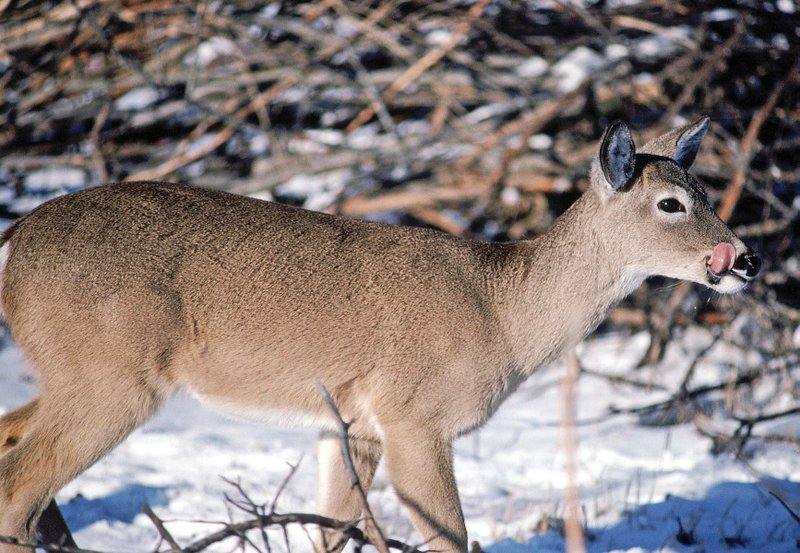When we see wildlife suffering through a frigid winter with little food, human nature compels us to help. We feel compassion for these poor creatures, and we know we can aid their survival by simply offering them something to eat.
Birds provide such an example. Millions of families throughout America provide seeds and other foods for our feathered friends. Wildlife agencies and conservation groups encourage us to do so, for without our help, songbirds and other backyard visitors would suffer unnecessarily in winter. Feeding birds, we’ve been taught, is a good thing to do.
But what about deer? Don’t they, too, need our help?
Today, more than ever, we are likely to see deer suffering the ravages of winter. In Arkansas and many other parts of the country, deer numbers have reached all-time highs, and deer often die from starvation because there’s not enough food to support all the animals through winter. Could we not save some deer by feeding them? Compassion tells us the answer must be yes.
“Back when white-tailed deer were hurting in much of the country, and winters were severe, sportsmen commonly made huge efforts to feed snowbound deer and other wildlife by hauling corn and other foods into the woods,” said retired
nature journalist George H. Harrison of Hubertus, Wisconsin. “Sportsmen felt good about getting food to winter-stressed animals they believed might not otherwise survive.”
Harrison joined one such effort in the early 1950s, flying in a small aircraft out of Pittsburgh with the Pennsylvania Aero Game Feeding Club. “I watched hundreds of pounds of corn being dumped over the Allegheny Mountains, where deer were trapped in deep snow,” he said. “It seemed like a worthy cause, and club members were lauded for their efforts.”
Harrison quickly pointed out, however, that current knowledge indicates that supplemental feeding is harmful, not helpful, to starving deer.
“Deer are ruminants and require weeks or months to adapt to new food types,” he noted. “And we now know that people who feed deer in urban areas exacerbate the problems of overpopulation and the destruction of habitat (including landscaping
and gardens) and increase the potential for spreading disease and causing collisions with vehicles.”
In a Wildlife Management Institute publication, “Feeding Wildlife … Just Say No!” author Scot J. Williamson summarizes scientific studies of supplemental wildlife feeding and delivers some startling revelations. If conditions are bad enough, or last long enough, the young, old and weak cannot compete with healthier animals for limited food supplies. Those that survive will be in poor condition, “lean, emaciated and without stored fat. Those in poorest shape may not reproduce or may have stunted or weak offspring,” Williamson said.
Then why not feed these starving animals? Because, Williamson notes, supplemental feeding: 1) leads to disease outbreaks that cause widespread mortality of big game, other wildlife and domestic animals; 2) leads to wildlife overabundance, causing damage to habitat, other species of wildlife, agriculture crops and forest products; 3) is extremely expensive if done properly, with little evidence of cost benefit; 4) decreases the general public’s acceptance of hunting and hunters; 5) increases political and social interference with wildlife-management-agency policies and operations; and 6) causes society to disregard the larger issue of wildlife habitat loss and degradation.
Let’s take a more in-depth look at some of these.
Winters tend to be relatively mild here in Arkansas compared to more northern states. But when we do have a harsh winter, it’s easy to feel empathy for whitetails with no apparent food to eat. It may seem the animals depend on us to survive.
Deer, however, are adapted for surviving long, cold winters in Arkansas and elsewhere in their range. Their fur provides insulation. Deer stock up on fat in the fall, so they do not need to eat as much in the winter. Additionally, their metabolism slows, and they restrict movement to conserve calories.
By spring, the deer have slimmed down, but despite being a bit skinny, most are healthy. Feeding deer, especially with high-calorie food, interrupts this natural pattern and speeds up their metabolism, making them burn fat reserves faster. Unlike humans, deer have a specific blend of microbes in their stomach that break down their naturally high-fiber
diet. These microbes take several weeks to adjust to new foods. During this period, deer are susceptible to corn-induced acidosis, which can cause diarrhea, dehydration and death. This creates a situation where you must continue feeding them through the winter, though they would have otherwise survived on their own before you intervened.
Deer that are fed by humans become dependent on the easy food source and stop foraging. Deer are much better at feeding themselves on their own. When you feed deer and then stop, or when the food temporarily runs out, they will go hungry and may become a nuisance as they search for more easily obtained food.
When deer are habituated, they can become demanding, even bumping at doors and
windows to get their expected handout. It may seem manageable to feed a doe with two fawns in the spring, but by fall, they become three adults demanding dinner every day. Additionally, landscaping and vegetation can be damaged where deer are concentrated around feeding areas. Before you put out food for deer, keep in mind that they are wild animals, not pets, and it’s better for you and for them if they stay wild.
If you are already feeding deer and would like to stop, slowly decrease the amount of food you are offering. Do not remove all the food at once. This way, the deer will have time to adjust their browsing habits and learn to eat on their own again.
“The preponderance of scientific evidence indicates that supplemental feeding of big game is a threshold that should not be crossed by the general public and only rarely, selectively, crossed by state or federal wildlife managers,” Harrison concluded.
